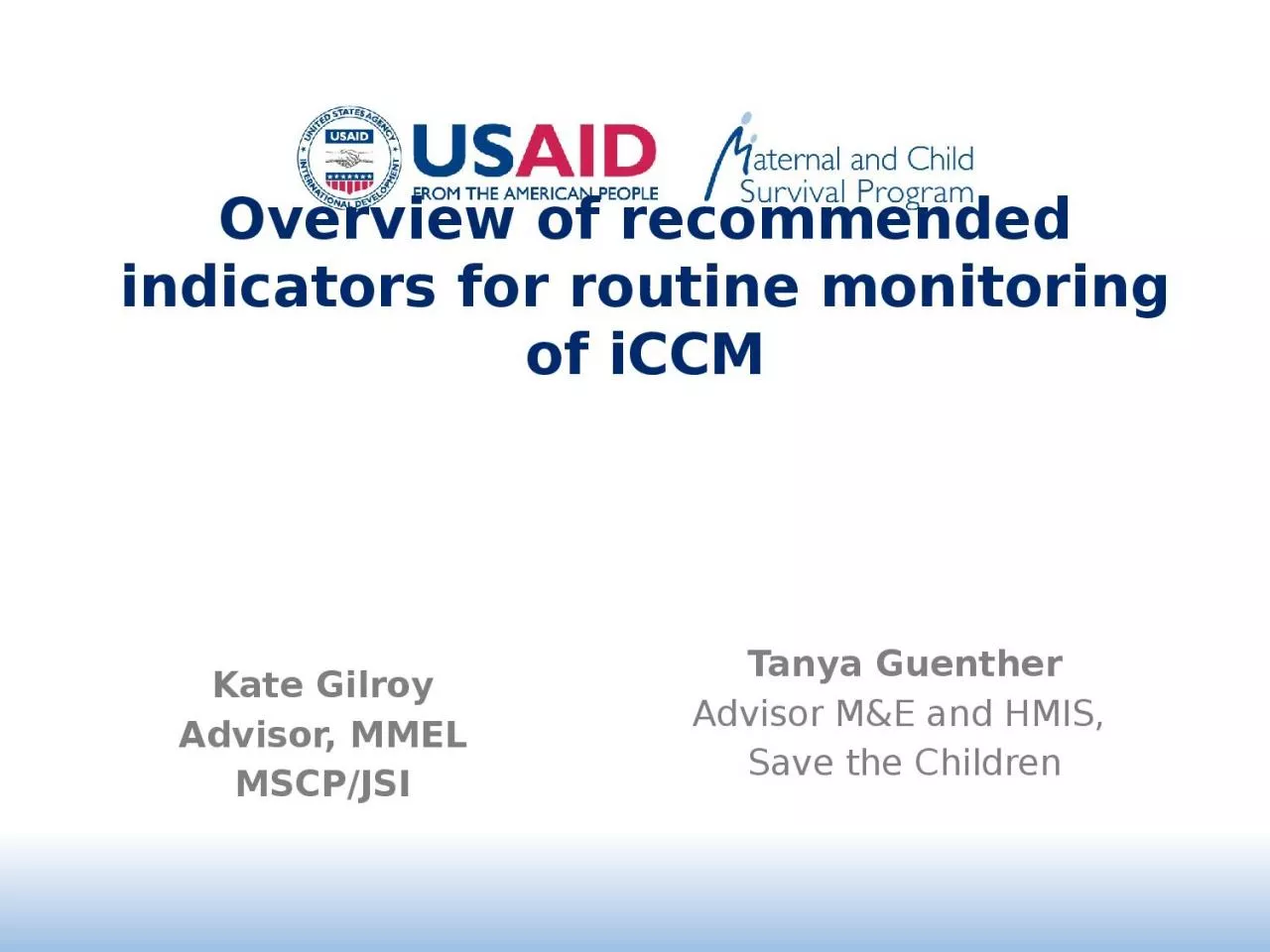

iCCM Kate Gilroy Advisor MMEL MSCPJSI Tanya Guenther Advisor MampE and HMIS Save the Children Process to Review and Refine iCCM indicators for Routine Monitoring The MampE sub ID: 1047879
Download Presentation The PPT/PDF document "Overview of recommended indicators for ..." is the property of its rightful owner. Permission is granted to download and print the materials on this web site for personal, non-commercial use only, and to display it on your personal computer provided you do not modify the materials and that you retain all copyright notices contained in the materials. By downloading content from our website, you accept the terms of this agreement.
1. Overview of recommended indicators for routine monitoring of iCCMKate GilroyAdvisor, MMELMSCP/JSITanya GuentherAdvisor M&E and HMIS, Save the Children
2. Process to Review and Refine iCCM indicators for Routine MonitoringThe M&E sub group of the global CCM Task Force started a process in Aug 2015 of reviewing the indicators and defining routine data needs at every level of iCCM implementationDeveloped an initial list of indicators and criteria for prioritizing the routine indicators
3. Process to Review and Refine iCCM indicators for Routine MonitoringFeedback on list of proposed indicators sought from other CCM TF subgroups and the Steering Committee – representing a wide range of partners supporting iCCM.The sub group has proposed a set of 10 indicators in 6 domains to be collected through routine systems: The sub group urges countries to identify opportunities to include these high value iCCM indicators in the DHIS or other national HMIS.Human Resources (3)Service Delivery (3)Supply Chain (1)Referrals (1)Reporting (1)Clinical coaching (1)
4. Routine Indicators: Human Resources Catchment population per ICCM CHW: Total population and estimated # of children under five per CCM siteiCCM program coverage for target population: Percentage of target communities (target population) with access to iCCM services CHW to supervisor ratio: Ratio of CHWs deployed for CCM to CCM supervisorsMeasurement notes:Data collected/updated annuallyCountries to define eligibility of target communities for iCCMRequires information on CHW and CHW supervisor training and deployment and population data for target communities
5. Routine Indicators: Service DeliveryiCCM case load by CHW: Average number of cases under five years of age seen for iCCM by CHW by report period iCCM treatment rate: Number of ** cases under five years of age treated by CHWs per 1,000 children under five years of age in target areas in a given time periodRDT+ MalariaSuspected Pneumonia (cough or difficulty breathing with a high respiratory rate for age)Diarrhea (can report ORS, zinc and ORS+zinc)Severe Acute MalnutritionModerate Acute MalnutritionRDT positivity rate: Percentage of fever cases under five years of age presenting to CHW who were tested with RDT and received a positive resultMeasurement notes:CCM treatment rate indicators enable routine assessment of utilization in iCCM target areas. Should be examined in comparison with the expected number of cases to draw inferences about estimated coverage of CHW treatment Only recommended where CHWs are treating SAM and MAM
6. Routine Indicators: Supply ChainMedicine and diagnostic availability: percentage of CHWs with all key iCCM medicines and diagnostics in stock on last day of reporting period low osmolarity ORS and zinc supplements for diarrheaamoxicillin for pneumoniaACTs and RDTs (where appropriate) for fever/malaria in malaria-endemic countriesothers required by program (tailor to each country’s needs)Measurement notes:SC group recommends countries work toward capturing continuous stock availability (% of CHWs with no stockouts in the past month) to gain a more complete picture of product availabilityCountries may opt to identify 1-2 items as ‘tracers’ to limit reporting burden and focus attention
7. Routine Indicators: ReferralsReferral rate: number of iCCM cases under five years of age recommended for referral by the CHW per 100 iCCM cases under five years of age seen by CHWMeasurement notes:Reasons for referral will often include danger signs or stock-outsNo ‘benchmark’ value exists; countries need to establish range and follow-up to determine reasons behind low or high valuesDoes not capture how well CHWs identify danger signs, whether referrals are made correctly, nor whether the referred child is actually taken to a health facility for careSpecial studies are recommended to better understand referral
8. Routine Indicators: ReportingReporting level: percentage of expected reports with iCCM data received during time periodMeasurement notes:Disaggregate by level (CHW, health facility, district)Does not provide information on the timeliness or quality of the data nor whether the data are being used by district, facility staff or CHWs to inform decision-making about CCM programs. Countries using DHIS2 may be able to track whether reports were received by reporting datePeriodic data quality audits are recommended to evaluate data quality and identify areas for improvement
9. Routine Indicators: Clinical CoachingClinical coaching/mentorship: percentage of CHWs who received clinical coaching/mentorship* in iCCM during reporting period; * - to be defined locally' Measurement notes:Definition of clinical mentorship/coaching activities will need to be determined by countries.Clinical mentorship and coaching activities are those that review and discuss the CHW quality of services and quality and accuracy of data completenessDoes not provide information on the quality of the mentorship or coaching, nor does it indicate whether the treatment of the sick child was considered appropriate
10. Next StepsM&E subgroup is close to finalizing indicator reference sheets that provide detailed information on definition, rationale, data sources and methods, interpretation and caveats.Will disseminate online and through meetings, conferences, workshops etc.Working to develop supporting tools (e.g. sample registers and reports; DHIS2 dashboards and visualization aids)Collaborating with other global initiatives to harmonize recommended indicators at community level (Global Data Collaborative, Global Fund, etc.)Please send your comments on these recommended indicators to kate_gilroy@jsi.com
11.